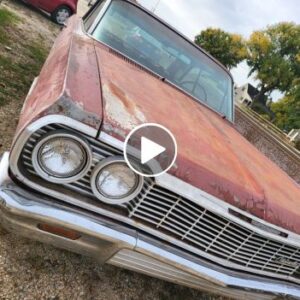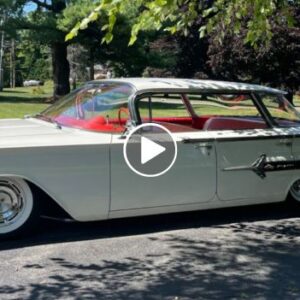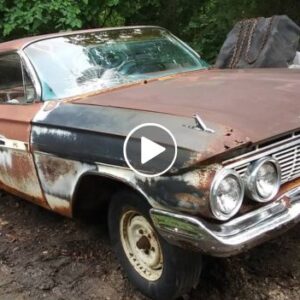Why would someone swap a 455 H.O. engine, TH400 transmission, 12-bolt rear end and heavy-duty suspension parts into a ’72 Le Mans post coupe, and in the process change its appearance to that of a ’71 T-37? The short answer is: to go racing. The slightly longer one is: Only 11 ’71 T-37s were built with that high-performance drivetrain, so the probability of spotting a real one on the street is exceedingly rare, and the chances of seeing one on the strip are more so. The even longer answer as to why that drivetrain was available in the T-37, the lightest and cheapest A-body Pontiac model for ’71, requires some more explanation.
A positive byproduct of the muscle car era was the emergence of the budget supercars. Automakers developed them to put performance in the hands of those who didn’t have the big bucks for a big-cube GTO, GTX, R/T, Torino GT, Cyclone GT, SS 396, GS 400 or 4-4-2 etc., or their insurance premiums, yet they still wanted to go fast with a midsized car. These econo-performers were usually stripped-down models with smaller displacement, yet still potent, engines, mild to wild identification and available–if not already included–upgraded suspensions.
Chevrolet got a head start with the hi-po 327 Chevelles and Malibus beginning in ’64, as did Buick with the ’67 GS 340 and 340-powered California GS. It was in ’68, however, when the movement gained momentum, spearheaded by the popularity of the 383-equipped Road Runner. There was also the 383-powered Super Bee, 350 H.O. Tempest, GS 350 and the Olds W31 350 F-85 and Cutlass, which were cheaper and lighter, and considered sleepers on the street. They also flew under the insurance companies’ radar, at least when compared to their generally quicker, higher-content and higher-profile brothers.
Mopar hedged its bets by also offering the top-performing 426 Hemi in the Road Runner and Super Bee, and then the 440-6 engines partway through ’69. Ford and Mercury simply made the 428CJ standard in the budget-muscle Cobra and Cyclone CJ for ’69. The large-displacement engines were now available in the lighter midsized bodies of Mopar and Ford, but GM still limited its intermediates to 400 cubic inches. That would begin to change with the dawning of a new decade.
Finally for 1970, larger engines were permitted to fill GM’s muscle car engine bays. The GTO and the more expensive and flamboyant GTO Judge resided at the top rungs of Pontiac’s A-body price ladder, and a new 360-hp 455 engine was optional. The Le Mans Sport and Le Mans held up the mid range, and the Tempest was the most affordable. Though the powerful 366-hp Ram Air III and 370-hp Ram Air IV 400s were not available in the lower lines, a 330-hp 400 small-valve, four-barrel engine with dual exhaust could be optioned in the Tempest, Le Mans, or Le Mans Sport, but only with the TH400 transmission.
At mid-year, the Tempest T-37 hardtop was released as a low-priced attention getter. The new stylish budget performer GT-37 was also introduced with ’69 Judge stripes, hood pins, Rally II wheels sans trim rings, G70-14 white-letter tires, through-the-valance twin-tipped dual-exhaust, a Hurst floor-shifted three-speed manual transmission and GT-37 emblems on the fenders and decklid. Standard in the GT-37 was the 255-hp 350 two-barrel engine and optional was the 265-hp 400 two-barrel or 330-hp 400 four-barrel. The latter two engines, equipped with the automatic only. Pontiac Sales Promotion Blueprint 70-54 from April 10, 1970, states that manual transmission-equipped GT-37s ordered with the 400 received the GTO drivetrain.
For 1971, the Tempest name was dropped in favor of T-37 for all base-model Pontiac A-bodies. The new 335-hp “round-port” 455 H.O. became standard in the Judge and optional in the GTO, GT-37, Le Mans Sport, Le Mans and T-37. The 12-bolt rear-end came with it, as did the M-13 three-speed manual transmission, unless the optional TH400 or M-22 close-ratio four-speed was specified. Though the N10 dual-exhaust option was mandatory, automatically included and shown as a separate charge, the heavy-duty suspension was not and had to be chosen by the buyer if desired. The 455 H.O. T-37 was the all-time sleeper of Pontiac’s factory-built A-bodies.
A 325-hp 455 D-port engine was also optional, but only with the TH400, and the available 400 four-barrel engine was now the same 300-hp big-valve engine used in the GTO, regardless of transmission choice.
The Le Mans name expanded to cover all the A-bodies for ’72, and the T-37 designation was dropped. From the base model up, there was the Le Mans, followed by the Le Mans Sport, Le Mans GT (which replaced the GT-37) and the Luxury Le Mans. Even the GTO reverted back to a Le Mans option. On the performance front, the optional 400 put out 250 net hp with dual exhaust, the 455 D-port produced 250 net hp and the 455 H.O. 300 net hp and was offered even in the lowest-priced Le Mans post coupe, as had been the case in ’71 with the T-37.
T-37 expert Dan Jensen recalls, “Ram Air was required with the 455 H.O. in ’72, which mandated the T41 Endura Styling Option. This added about 100 pounds to the nose of the ’72 A-body H.O. cars. Unitized ignition was also a required option, as was the TH400 or the close-ratio four-speed.”
Some may feel that building a ’72 455 H.O. Le Mans tribute doesn’t carry the same wow factor as a ’71 455 H.O. T-37 tribute, since the Le Mans had been known as a mid-level to upscale bucket-seat model for a decade, and the T41 (GTO) nose would be required with the 455 H.O. to make it appear factory correct. The T-37 comes with the connotation of being a low-buck stripper with a bench seat, but ’71 was the only year that you could get one with the 455 H.O. and only four automatic and seven manual transmission examples were built.
Former owner of our feature car and Pontiac racer and restorer John Glasgo says that he liked the idea because the 455 H.O. T-37 represented, “the biggest motor in the lightest body that you could get in ’71.” He purchased this ’72 Le Mans out of Northern California, sight unseen, from the original female owner around 2002 and had it shipped to Ohio. “Nice post cars with no A/C were tough to find even then,” he recalls.
It left the factory with Quezal Gold paint, a 350 two-barrel engine, TH-350 transmission and a highway-geared rear end. Inside was a saddle bench-seat interior and column shifter. Additional options were limited to power steering, recessed wipers, custom carpet and an AM radio. The Le Mans was originally sold from Arata Pontiac in Burlingame, California.
John purchased the car to go F.A.S.T. (Factory Appearing/Stock Tire) racing, and felt he could build a competitive combination. The transformation to T-37 included the powertrain swap to a 455 H.O., TH400, a 12-bolt rear end and suspension updates. It also involved swapping in the ’71 grilles and 455 emblem and removal of the arrowhead on the header panel. The “Le Mans” emblems were exchanged for “Pontiac” and “T-37” emblems on the front fenders and were also removed from the interior door panels. Replacing the front seat upholstery was also required. John added factory-style “sword” side stripes sans GT-37 callouts, hood pins and Rally II wheels with G70-14 Polyglas GT tires. He re-dyed some interior parts, added Rally gauges, removed the front clip to detail from the firewall forward and did a few “blow-ins” where the original paint needed to be touched-up. He campaigned it for a while, running low 12s, but when the competitive ETs in the series neared the point that would require the installation of a roll bar to pass tech, he decided to retire the car.
Dan Jensen, also a racer and cofounder of the Pure Stock Muscle Car Drag Race (PSMCDR or PSD), purchased the Pontiac from John in late 2004. “I had raced my original ’71 455 H.O. T-37 that I bought back in 1983, but since it’s a 1-of-4 car, I became concerned about continuing to do so given its rarity,” he explains. “This car, however, would allow me to still enjoy racing a sleeper Pontiac without the worry.”
He removed the side stripes with the help of a heat gun, swapped the springs to lower the ride height a bit, installed new suspension bushings and replaced the Rally II wheels with body-colored steel ones, standard hubcaps and G70-14 Firestone tires. It ran mid-12s as a ’71 T-37 Pure Stock competitor.
Restorer Steve Kovacs of Classic Car Restoration LLC in Lowell, Michigan, called his friend Dan in the spring of 2014. He had acquired a 455 with ’71 H.O. parts on it about a year earlier and was looking for an interesting Pontiac in which to install it.
Oddly enough, he found the engine not in a ’71-’72 A- or F-body, but in a ’79 Trans Am. Steve recalls, “The ad for the car had been running in the local paper for three weeks, and my friend Eric Whitney kept telling me to go look at it. Since it was only 10 minutes from my house, I finally did. The T/A had been sitting in a barn for about 20 years, but at some point, it did have a 455 transplanted into it. The engine was complete and the reciprocating assembly wasn’t frozen. All I found was a bad valve spring. The rest of it looked like new inside, so I bought it.”
The block was a 1970 code-YH, four-bolt main 455. There was a new crank in it and early forged-steel Pontiac rods had been employed. Its top-end consisted of #197 round-port ’71 455 H.O. heads and the H.O. factory aluminum intake manifold. Steve delivered it to Pierce Race engines in Lansing, Michigan, for freshening. He also found and had restored, a 750-cfm Quadrajet, which is correct for the ’71 400 and D-port 455 and is more prevalent than the rare 800-cfm 455 H.O. unit.
Dan had another project in which he could use the 455 H.O. that was in his T-37-trimmed Le Mans, so Steve bought the Pontiac sans its engine, but otherwise complete, with a rebuilt TH400 transmission and 3.73-geared 12-bolt rear-end.
With the intention of building it into a tire-smoking street car and possibly doing some Pure Stock racing, Steve installed his rebuilt engine. He also decided to paint the roof white. In the process, he added a flattening agent to get the sheen to match that of the mostly original paint on the body. The white roof with bright trim adds to the no-frills vibe, since back when these cars were new, ordering a contrasting-color painted roof to achieve a two-tone appearance was a less expensive alternative to the optional Cordova vinyl top.
Further contributing to a muscular yet low-buck look, Steve added T-37 eyebrow stripes, which are comprised of two colors–red and white in this case, or red and black–and slightly smaller than the more commonly seen three-color Judge-style stripes that were offered in multiple hue combinations. He also replaced the gutted AM radio with a functional one, reinstalled a power steering system, swapped in gas shocks and added a rear anti-roll bar, reproduction 14 x 7-inch (one inch wider than stock) steel wheels–painted black–and new tires.
Out on the streets, the Pontiac drew lots of attention, according to Steve, and that’s where he’s enjoyed it most. Though he’s raced other cars at the Pure Stock drags for decades, thus far, this one has only competed once. Whether or not it hits the strip again is less important than the fact that this ’72 Le Mans-turned-’71 T-37 unifies multiple Pontiac concepts and styling cues within a distinctive package to view and drive. And that was the intent of its last three owners.






